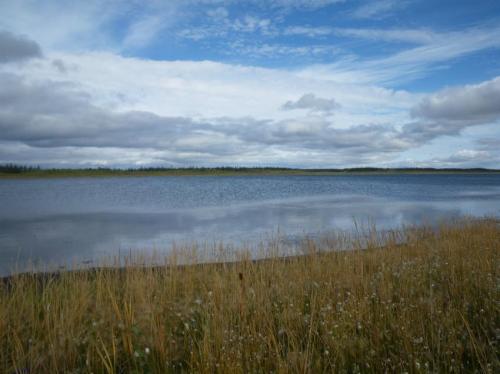How did they come to that conclusion? Computer modeling, of course. It's amazing what you can make a computer do.
Some Alaskan lakes have shrunk since the 1950s, while others have expanded, says a recent article in Live Science. "Earlier studies suggest that melting permafrost plays a role in the shifting lake sizes," the article explains. "For example, lakes may drain away when the shallow permafrost below them thaws, like opening the drain in a tub .... where permafrost is thicker and melts more slowly, lakes may grow as the melting ice adds to their extent."
In other words, it makes no difference whether those lakes expand or shrink, it's still caused by global warming.
The ground is thawing? Blame global warming. The ground is freezing? Blame global warming.
As I said, it's amazing what you can make a computer do.
Twelvemile Lake - so-named because it's 12 miles from the town of Fort Yukon - is one of millions of lakes that dot Alaska's permafrost landscape. (Permafrost is soil containing ice that stays frozen for more than two years.)
"These lakes are the bellwether of climate change," says Martin Briggs, lead study author and a research hydrologist with the U.S. Geological Survey.
Briggs is certain that the permafrost at Twelvemile Lake is new, because he's been tracking vegetation growth near the receding lake during the past 20 years.
As the lake receded, bands of willow shrubs grew on the newly exposed shores, and patches of permafrost recently appeared under the shrubs.
Briggs, along with Prof. Jeffrey McKenzie from McGill's Dept. of Earth and Planetary Science, concluded that the extra shade provided by the new shrubs both cooled and dried the soil, enabling the ground to now remain frozen year-round.
According to their computer simulations (there's that computer thing again), the permafrost at Twelvemile Lake could reach a maximum of 20 feet (6 meters) in about 45 years, and then start melting again.
Oh, wait. Maybe it's simply a natural cycle
The article waits until the very end - the final two paragraphs - before mentioning that some lakes "are shrinking simply because the region is receiving less rainfall than 30 years ago."
According to a study led by USGS research geologist Lesleigh Anderson, "Central Alaska regularly goes through wetter and drier periods, such as those driven by the Pacific Decadal Oscillation, a climate cycle that flips sea-surface temperatures in the north Pacific every 20 to 30 years."
Hmmm. Shall we believe the computer models?
Or shall we believe the actual physical observations showing that these wet/dry fluctuations are the result of a natural cycle?
Anderson's study was published July 24, 2013, in Geophysical Research Letters. The permafrost study was published on Feb. 14, s 2014, also in Geophysical Research Letters.
Despite Warming, Ground Refreezes at Alaska's Shrinking Lakes
New permafrost is forming around shrinking Arctic lakes
New permafrost is forming around shrinking Arctic lakes
Thanks to Jim Shepherd and Marc Morano for these links
"Permafrost around Alaskan lakes is growing," says Jim. "And yet the warm-mongers insist that it is only temporary and in seven decades will start to decline due to global warming. Who will be around in 70 years to verify such biased reporting?"




Computer Models are like slaves: You tell them what you want to output, and they do exactly as they are told (programmed).
Models based purely on theory are easy to spot: They put out forecasts that follow straight lines, in this case, forever upwards at a steady rate.
The ground in Alaskan lakes is refreezing because the Poles are getting colder, and they are getting colder because the Sun has been at Low to Very Low output since 2008. The Sun is in a natural Rip Van Twinkle cycle, of what exact length nobody has the skill to accurately forecast.